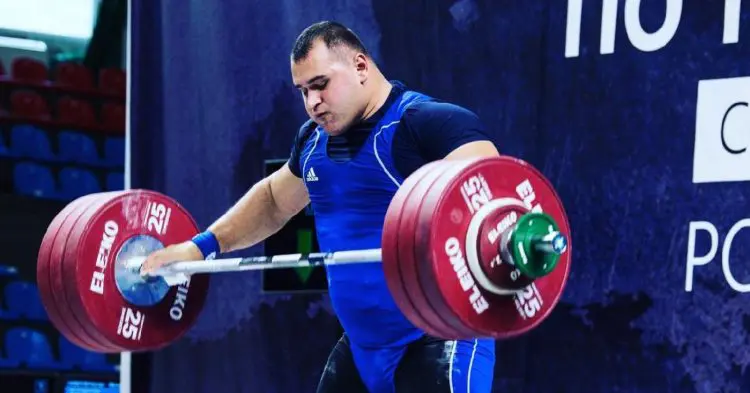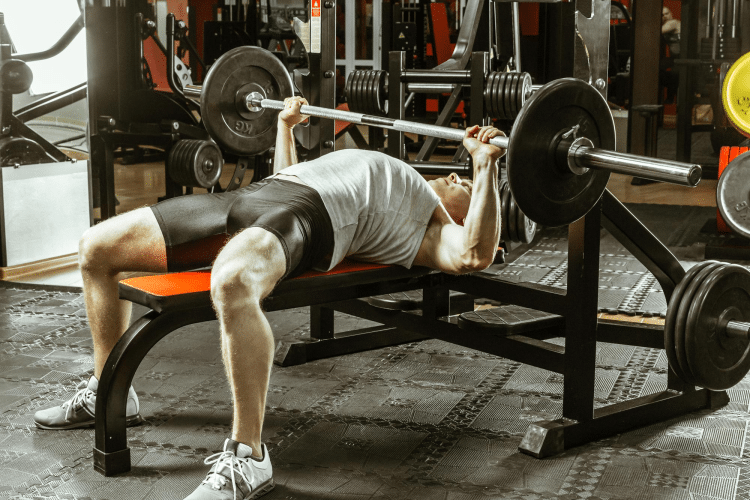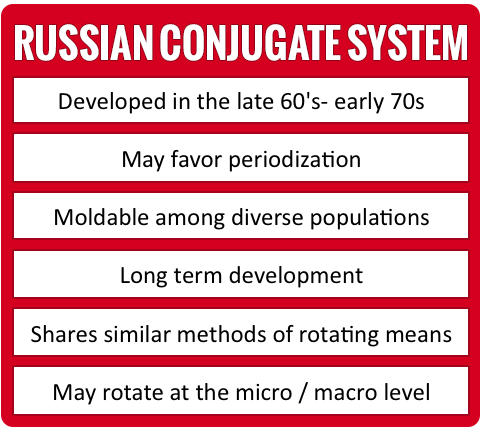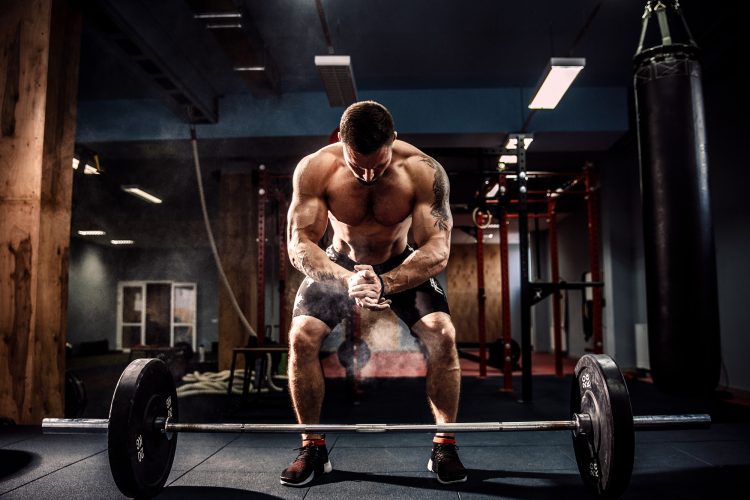Whether you are a beginner gym-goer or an elite athlete, the goal is always to get stronger — fast. Whenever you talk about getting bigger, stronger, and faster, the conversation ultimately pivots toward the Russians and their training methods. It is no different for this article.
Let’s be honest: hitting a training plateau is inevitable, especially for advanced lifters. New diets, supplements, and conventional training programs might also not be enough to break through an overhead ceiling.
This is where the Russian conjugate method shines.
While it’s often dismissed as a relic from the Soviet Union, it’s, in fact, a bizarre method of building strength that first intrigued me and then convinced me of its potency with exceptional results.
In this article, I decode everything you need to know about this program, including its history and how to incorporate it into your workout for the best results. So sit tight and read on to build strength the hardcore way.
Introduction — Russian Conjugate Method
The Russian conjugate method was developed by Soviet sports scientists to help their Olympic athletes bag medals for their fatherland. This strength training method combines maximal lifts, dynamic efforts, and targeted accessory work to build raw power, explosiveness, breakthrough strength, and muscle plateaus.
Level Up Your Fitness: Join our 💪 strong community in Fitness Volt Newsletter. Get daily inspiration, expert-backed workouts, nutrition tips, the latest in strength sports, and the support you need to reach your goals. Subscribe for free!

Historical Context: The Rise and Fall of Soviet Strength
Contrary to what most people think, the Cold War (1947-91) wasn’t just about nukes and spies; it was about gaining global dominance on every stage, including the weightlifting platform.
Given its versatile nature, you could think of the Russian conjugate method as a Swiss Army knife of strength training. It combined max effort, dynamic effort, and hypertrophy into one comprehensive program.
Yuri Verkhoshansky (the “Father of Plyometrics”) and Anatoli Bondarchuk (coach of multiple Olympic champions) were the brains behind the Russian conjugate method. These guys utilized the most cutting-edge research and their own experience lifting weights to build this method.
The Russian conjugate method involves periodization, peaking for competition, and pushing the human body to its limits to improve in every field.
Soviet athletes were shattering records, dominating every international competition they entered.
Just when everything was looking good for the sports teams, the Soviet Union collapsed, and the conjugate method vanished into the shadows.
Read also: Introduction to Conjugate Training.
Why The Russian Conjugate Method Failed?

Here are some reasons why this training method got sidelined:
Language Barrier
The language barrier was arguably the biggest reason why this method fell out of favor. Most of the original research and training manuals were published in Russian and were inaccessible to most Western coaches and athletes.
The thing is, only a few people actually knew about this training protocol, even when the Soviet athletes were dominating competitions. Talk about an iron curtain.
Rise of Other Training Philosophies
While the conjugate method diluted, Western training philosophies took off. That’s not all. At about the same time, bodybuilding, with its emphasis on aesthetics, and powerlifting, with its focus on raw strength, gained popularity.
Unlike the conjugate method, these new training regimens and their principles were easier to understand and implement.
Full disclosure: the conjugate method didn’t vanish entirely. It was still practiced on a small scale in Eastern Europe by a few strength enthusiasts. However, it is now experiencing a resurgence, backed by science, decades of results, and a keen community.
Principles of the Conjugate Method
Most training programs focus on one aspect of strength at a time; the Russian conjugate method does not follow this approach.
It involves maximal strength, dynamic effort, and hypertrophy training all at once. The three-pronged approach ensures maximal output and results.
Here is what each of these approaches entails:
- Maximal Strength: Lift as heavy as possible and push your limits.
- Dynamic Effort: Speed and explosiveness are key here. It’s especially important for Olympic weightlifters.
- Hypertrophy: Focuses on building muscle tissues and improving physique aesthetics.
While it might sound like a lot, the conjugate method workout structure simplifies everything.
Workout Structure — Russian Conjugate Method
Ever heard of organized chaos? That’s how I could describe this training method. The Russian conjugate method is a carefully organized system that cycles through different phases to ensure variety and avoid plateaus.
Level Up Your Fitness: Join our 💪 strong community in Fitness Volt Newsletter. Get daily inspiration, expert-backed workouts, nutrition tips, the latest in strength sports, and the support you need to reach your goals. Subscribe for free!
Here is a gist of the program:
Microcycles
These are usually one-week blocks where you focus on specific training qualities. For instance, you perform heavy bench presses in the first week to build strength and do faster, lighter plyometric work in the second week to build explosive strength.
Mesocycles
Mesocycles usually last for a few weeks to a couple of months. In this, you group microcycles with similar goals to ensure maximum output block before moving on to the next mesocycle.
Macrocycles
These can last a year or even longer in some specific cases. It groups multiple mesocycles to achieve your training objectives.
Periodization: The Art of Peaking
To me, periodization is the most interesting aspect of a training program. For the uninitiated, it involves progressive cycling of various aspects of a training program during a specific period.
This is also how competitive athletes manage to peak for a contest just at the right time. It’s the strategic manipulation of training intensity and volume over time.
In the Russian conjugate method, you could start a mesocycle with high volume and moderate intensity to build a base of strength and muscle. However, as you progress, the volume decreases while the intensity goes up, allowing you to peak for maximal strength or dynamic effort.
One of the best parts about this systematic approach is that it keeps your body guessing and prevents you from hitting an overhead ceiling. You are always pushing yourself in the gym but in a controlled and responsible way.
Remember, the conjugate method is not set in stone. You must design and adapt the training program according to your unique needs. Learn to listen to your body to maximize your results and limit injury risk.
Key Exercises in the Russian Conjugate Method
These are the most basic lifts in this program:
- Deadlifts: Picking something heavy off the floor and putting it back down is incredibly badass. Deadlifts are essential for building total-body strength.
- Bench Press: Incorporate different variations (incline, decline, close-grip) to ensure overall development.
- Squats: This full-body exercise promotes overall growth. Front squats, back squats, and box squats are all part of this program.
- Olympic Lifts: You cannot forget this program was developed for Olympic weightlifters. Snatch and clean & jerk are fundamental exercises in this program. These lifts are also incredibly effective for building explosive power and athleticism.
Putting it into Practice: Sample 8-Week Conjugate Training Plan
We now come to the meat and potatoes of this article — the Russian conjugate method training programming.
The eight-week plan below incorporates the principles of maximal effort work, dynamic effort work, and hypertrophy to create a well-rounded lifter.
Monday: Maximal Effort Lower Body
- Exercise: Back Squat (or Front Squat if preferred)
- Sets/Reps: 5 sets of 3 repetitions
- Intensity: 85-95% of 1-repetition maximum (1RM)
- Accessory Work: Romanian Deadlifts, Glute Bridges (3 sets of 8-12 reps)
Tuesday: Dynamic Effort Upper Body
- Exercise: Bench Press (or Overhead Press)
- Sets/Reps: 6 sets of 2 repetitions
- Intensity: 50-60% of 1RM, focus on explosive movement
- Accessory Work: Pull-Ups, Dumbbell Rows (3 sets of 10-15 reps)
Thursday: Maximal Effort Upper Body
- Exercise: Deadlift (Conventional or Sumo)
- Sets/Reps: 5 sets of 1 repetition
- Intensity: 90-100% of 1RM
- Accessory Work: Barbell Curls, Triceps Extensions (3 sets of 8-12 reps)
Friday: Dynamic Effort Lower Body
- Exercise: Box Jumps or Jump Squats
- Sets/Reps: 5 sets of 3 repetitions
- Intensity: Maximal effort, focus on explosiveness
- Accessory Work: Leg Press, Hamstring Curls (3 sets of 10-15 reps)
Progression Over Eight Weeks
Now, you must consistently challenge yourself to make consistent progress. Here is how to do it on this program:
- Weeks 1-2: Use the first two weeks to establish a baseline. Focus on drilling the movement mechanics and use weights that you but allow the proper technique.
- Weeks 3-4: Gradually increase the weight on maximal effort days by 2.5-5 percent each week, maintaining the rep ranges prescribed above. On dynamic days, focus on increasing bar speed.
- Weeks 5-6: Increase weight, potentially shifting to five sets of two reps on maximal days. On dynamic days, add resistance bands or chains for a unique resistance profile.
- Weeks 7-8: The final two weeks are where you go all out. Attempt new personal records (PRs) on maximal days and maintain explosiveness on dynamic days.
I highly recommend that beginners work with a professional to design personalized training programs for optimal efficiency and results.
My Experiment: Results and Reflections

As a personal trainer with over 17 years of lifting experience, I wanted to try the Russian conjugate method for myself. I had my own doubts initially, as juggling max effort, dynamic effort, and hypertrophy work all in a single program sounded like too much work to me.
Furthermore, it isn’t a plug-and-play type of program. You must design it as per your experience level and unique goals.
That said, about six weeks in, it all clicked for me, and my body adjusted to the mesocycles and the different lifting days. All my major lifts improved, and my bench press, which is one of my weakest lifts, jumped a massive 15 pounds. I also added 20 pounds to my deadlift. That’s not all; this program made my muscles dense and more defined.
Results of the Program
Here is the improvement in the three big lifts:
| Lift | Before (8 weeks) | After (8 weeks) | Gain |
| Squat | 315 pounds | 350 pounds | +35 pounds |
| Bench Press | 225 pounds | 240 pounds | +15 pounds |
| Deadlift | 390 pounds | 410 pounds | +20 pounds |
This is how my body composition changed:
| Measurement | Before | After | Change |
| Lean Mass | 180 pounds | 184 pounds | +4 pounds |
| Body Fat | 17.5% | -15.5% | -2% |
The mindset shift is one of the most downplayed benefits of the conjugate method. Each workout feels like an adventure as you switch between different objectives. The variety keeps you on your toes, and the constant challenge is very motivating.
The Resurgence: Why the Conjugate Method is Making a Comeback
This is how the Russian conjugate method is different from the conventional training methods:
- Variety: The human body is designed to be incredibly adaptive. The constantly evolving conjugate method provides enough constant stimuli to ensure consistent progress.
- Strength and Hypertrophy: Most training programs treat strength and hypertrophy as separate entities, but not the conjugate protocol. It focuses on building brute strength and muscle size, giving you the best of both worlds.
- Addresses Weaknesses: This method incorporates accessory exercises to target weaknesses and build a balanced physique.
- Injury Prevention: Since we are constantly varying the workouts, the risk of overuse injuries is limited.
- Mental Stimulation: On the conjugate method, you cannot expect to show up to the gym and make up your workout on the fly. To see meaningful progress, you must come in with a plan to keep things fresh and engaging.
Conclusion
The Russian conjugate method is among the most effective but forgotten Soviet lifting techniques that are making a comeback. It isn’t just about making gains but rediscovering the joy of lifting. I highly recommend this program to people who want to step out of their comfort zone and challenge themselves in each workout.
If you have any questions about the conjugate method, drop them in the comments below, and I’ll be happy to help!
Next read:
- 5 Essential Candito Training Programs For Powerlifters
- Developing Your Deadlift With The Ed Coan Routine
- The Cube Method: Improve Your Powerlifting Performance
- The Bulgarian Squat Method
- nSuns 531 LP Powerlifting Program Guide with Spreadsheets










